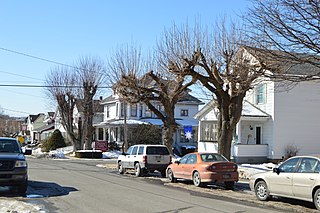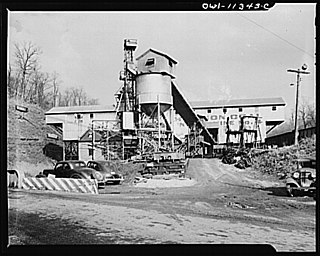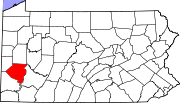
Bethel Park, referring to itself as the Municipality of Bethel Park, is a borough with home rule status in Allegheny County, Pennsylvania, and is part of the Pittsburgh Metro Area, approximately 7 miles (13 km) southwest of Pittsburgh. The population was 32,313 at the 2010 census.

Castle Shannon is a borough in Allegheny County, Pennsylvania, United States, and is part of the Pittsburgh Metro Area. The population was 8,316 at the 2010 census.

Gilpin Township is a Second class Township in Armstrong County, Pennsylvania, United States. As of the 2010 census it had a population of 2,496.

Portage is a borough with home rule status in Cambria County, Pennsylvania, United States. It is 10 miles (16 km) southeast of Ebensburg and 22 miles (35 km) southwest of Altoona. It is part of the Johnstown, Pennsylvania Metropolitan Statistical Area. The population was 2,638 at the 2010 US census.

Boswell is a borough in Somerset County, Pennsylvania, United States. It is part of the Johnstown, Pennsylvania Metropolitan Statistical Area. The population was 1,364 at the 2000 census.

Rivesville is a town and former coal town in Marion County, West Virginia, United States. The population was 934 at the 2010 census.

The United Mine Workers of America is a North American labor union best known for representing coal miners. Today, the Union also represents health care workers, truck drivers, manufacturing workers and public employees in the United States and Canada. Although its main focus has always been on workers and their rights, the UMW of today also advocates for better roads, schools, and universal health care. By 2014, coal mining had largely shifted to open pit mines in Wyoming, and there were only 60,000 active coal miners. The UMW was left with 35,000 members, of whom 20,000 were coal miners, chiefly in underground mines in Kentucky and West Virginia. However it was responsible for pensions and medical benefits for 40,000 retired miners, and for 50,000 spouses and dependents.

The Coal Region is a historically important coal-mining area in Northeastern Pennsylvania in the central Ridge-and-valley Appalachian Mountains, comprising Lackawanna, Luzerne, Columbia, Carbon, Schuylkill, Northumberland, and the extreme northeast corner of Dauphin counties. Academics have made the distinction North Anthracite Coal Field and South Anthracite Coal Field, the lower region bearing the further classification Anthracite Uplands in physical geology. The Southern Coal Region can be further broken into the Southeastern and Southwestern Coal Regions, with the divide between the Little Schuylkill and easternmost tributary of the Schuylkill River with the additional divide line from the Lehigh watershed extended through Barnesville the determining basins.
Consol Energy Inc. is an American energy company with interests in coal headquartered in the suburb of Cecil Township, in the Southpointe complex, just outside Pittsburgh, Pennsylvania. In 2017, Consol formed two separate entities: CNX Resources Corporation and CONSOL Energy Inc. While CNX Resources Corp. focuses on natural gas, spin-off Consol Mining Corporation, now Consol Energy Inc. focuses on coal. In 2010, Consol was the leading producer of high-BTU bituminous coal in the United States and the U.S.'s largest underground coal mining company. The company employs more than 1,600 people.

Star Junction is an unincorporated community and census-designated place in Perry Township, Fayette County, Pennsylvania, United States. The community is located on Pennsylvania Route 51. At the 2010 census, the population was 616.
The Westmoreland County coal strike of 1910–1911, or the Westmoreland coal miners' strike, was a strike by coal miners represented by the United Mine Workers of America. The strike is also known as the Slovak Strike because about 70 percent of the miners were Slovak immigrants. It began in Westmoreland County, Pennsylvania, on March 9, 1910, and ended on July 1, 1911. At its height, the strike encompassed 65 mines and 15,000 coal miners. Sixteen people were killed during the strike, nearly all of them striking miners or members of their families. The strike ended in defeat for the union.

Whitsett is an unincorporated community in Fayette County, Pennsylvania, United States, about 30 miles (50 km) south of Pittsburgh population is around 200. It was founded in 1845 by Ralph C. Whitsett, Sr. He and his family built a large red brick house in 1873, which still stands today. The community is made up of mostly “company” houses that were built for workers that worked in a large coal mine located nearby, the mine was Banning #21. Most of the houses were ½ houses built to accommodate two families. The mine has been closed since 1954 and most of the houses have been renovated and turned into single-family dwellings.

Fannie Sellins was an American union organizer.
Broughton is an unincorporated community in South Park Township, Pennsylvania. Originally named Curry after Dr. Joseph Curry, frontier physician and Coroner of Allegheny County in 1810, it was renamed Broughton, to avoid confusion with the nearby Curry Hollow and the Curry in Blair County, Pennsylvania. It is located at the junction of Brownsville Road, Curry Road, and Broughton Road. It was racially integrated in the early 20th century, due to coal miners working nearby mines in Horning, Pennsylvania. It was the location of Pittsburgh Terminal Coal Company's No. 5 mine.
Streets Run is a 5.2-mile-long (8.4 km) tributary of the Monongahela River in Allegheny County, Pennsylvania. This urban stream drains portions of the communities of Pittsburgh, Baldwin, Brentwood, West Mifflin and Whitehall, an area of about ten square miles.

The Pittsburgh Coal Company was a bituminous coal mining company based in Pittsburgh and controlled by the Mellon family. In 1945 it merged with Consolidation Coal Company, controlled by the Rockefeller family.

Mine 3 was a station on the Port Authority of Allegheny County's light rail network, located in Bethel Park, Pennsylvania. The small station was located directly adjacent to an industrial park and was designed mainly as a way to provide access for workers at the associated businesses.

People have worked as coal miners for centuries, but they became increasingly important during the Industrial revolution when coal was burnt on a large scale to fuel stationary and locomotive engines and heat buildings. Owing to coal's strategic role as a primary fuel, coal miners have figured strongly in labour and political movements since that time. After the late 19th century coal miners in many countries were a frequent presence in industrial disputes with both the management and government. Coal miners' politics, while complex, have occasionally been radical, with a frequent leaning towards far-left political views. A number of far-left political movements have had the support of both coal miners themselves and their trade unions, particularly in Great Britain. In France, on the other hand, coal miners have been much more conservative.
The 1927 Indiana bituminous strike was a strike by members of the United Mine Workers of America (UMWA) against local bituminous coal companies. Although the struggle raged throughout most of the nation's coal fields, its most serious impact was in western Pennsylvania, including Indiana County. The strike began on April 1, 1927, when almost 200,000 coal miners struck the coal mining companies operating in the Central Competitive Field, after the two sides could not reach an agreement on pay rates. The UMWA was attempting to retain pay raises gained in the contracts it had negotiated in 1922 and 1924, while management, stating that it was under economic pressure from competition with the West Virginia coal mines, was seeking wage reductions. The strike proved to be a disaster for the union, as by 1929, there were only 84,000 paying members of the union, down from 400,000 which belonged to the union in 1920.


















